How to grow petunia from seeds at home: sowing seedlings, care, transplanting into open ground
Petunia is one of the most popular flowers among gardeners. Low-growing ornamental plants bloom profusely and for a long time and look harmonious as a frame and decoration for a flower garden.
Adult plants are easy to care for. But seedlings require patience and diligence, so many gardeners prefer to buy them in nurseries and markets. However, such planting material is expensive and is not always healthy and of high quality. It is much safer and cheaper to grow seedlings yourself from seeds. This is the most difficult stage of cultivating a plant, but knowing the basic principles and nuances, even a beginner can cope with it. Read on to learn how to plant and when to sow seeds.
Planting petunia seedlings from seeds at home
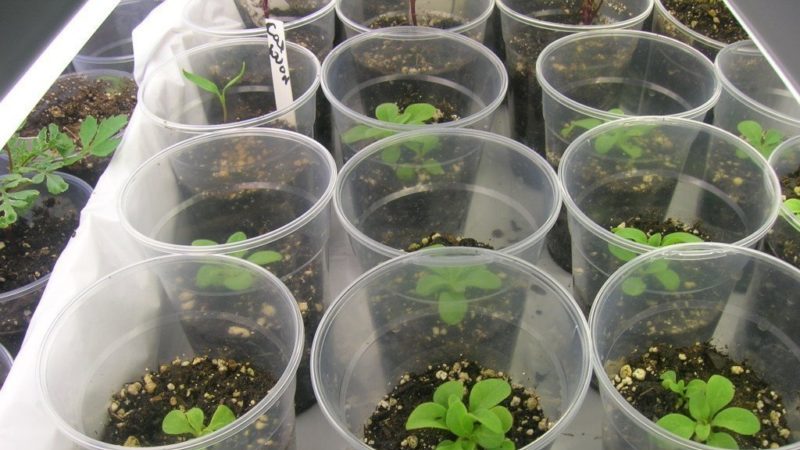
It is necessary to select suitable planting material. Petunia seeds are sold in specialized and online stores. Sometimes they are found in regular supermarkets.
You should not buy seed in the markets. Self-collected seeds often give unpredictable results. This plant cross-pollinates easily, so flowers grown from seeds often look different from the mother plant.
Note! Exist varieties and petunia hybrids, which do not produce seeds and reproduce only vegetatively.
There are two types of planting material sold in stores - granular and loose.The first one is covered with a special shell, which makes it larger. Such seeds are easy to sow by spreading them at the required distance from each other. They have already been processed at the factory, so you won’t have to waste time on this stage.
The disadvantage of granular planting material is that sometimes the shell prevents it from germinating. Such seeds are more expensive than loose seeds, and there are fewer of them in the package.
Loose planting material is cheaper. Such seeds are often not processed in the factory. The gardener has to spend time preparing them. They are small, which makes sowing them difficult. Despite this, they are also in demand.
Landing dates
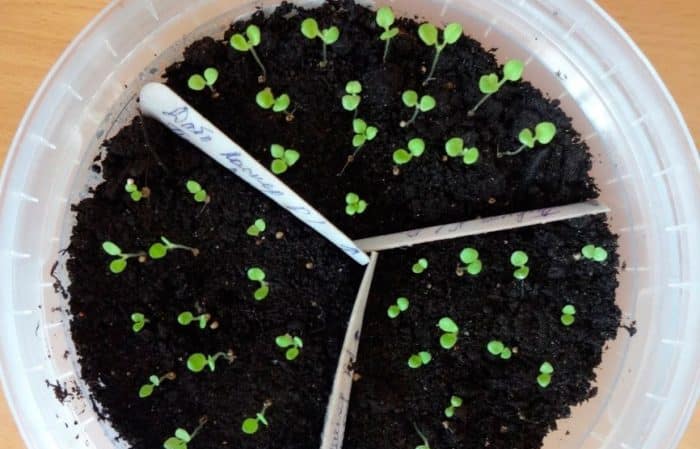
On average, from sowing the seeds to the flowering of the plant, it takes from 10 to 12 weeks. At growing petunias from seeds, planting dates depend on exactly when the gardener wants to see flowering bushes in his garden, as well as on the temperature outside.
In the southern and central regions, petunia is grown from mid-January to the end of February. To get healthy and strong seedlings, you will need special lighting (fluorescent lamps or phytolamps). If there is no additional lighting, the seeds are sown from early March to early April.
In Siberia and the Urals, sowing occurs in mid-spring (April). In this case, the strengthened seedlings will be ready for planting when the weather warms.
Experienced gardeners recommend taking into account the indicators of the lunar calendar when choosing the timing for planting petunias. It is believed that plants planted at the right time are stronger and healthier.
When to plant petunia according to the lunar calendar in 2020:
| Month | Suitable days | Bad days |
|---|---|---|
| January | 10-11, 15-20 | 5-9, 22 |
| February | 1-4, 6, 10-11, 16-18, 25 | 9, 21-23, 26-27 |
| March | 3-5, 27-28 | 1-2, 7-8, 10, 12, 14-16, 19-24, 31 |
| April | 1-2, 7-8, 14, 24, 28 | 3-5, 9, 11-13,15-22 |
On unfavorable days, it is not recommended to sow flowers for seedlings.Seed germination at this time will be low, and the plants will be weak.
Days that are not listed in the table are considered neutral. They are not considered favorable, but during this period you can also sow planting material.
Seed preparation
Granulated and loose seeds that have been processed in the factory do not need to be further processed. Information about this is indicated on the packaging.
If the seeds have not been processed in the factory, they must be prepared for planting. To do this, the seeds are disinfected by soaking for 30 minutes. in a light pink solution of potassium permanganate, hydrogen peroxide or Fitosporin. Then their growth is stimulated by soaking them for a day in a solution of “Epin” or “Solution”.
After this, the seeds are ready for planting. Some gardeners prefer to germinate planting material in advance. To do this, cover the saucer or plate with several layers of gauze, which is moistened with warm water. Seeds are poured on top in one layer and covered with gauze, which is also moistened with water. Cover the saucer with film and put it in a warm place. As the gauze dries, moisten it. The seeds are kept in this form until they germinate.
Selection of container and soil
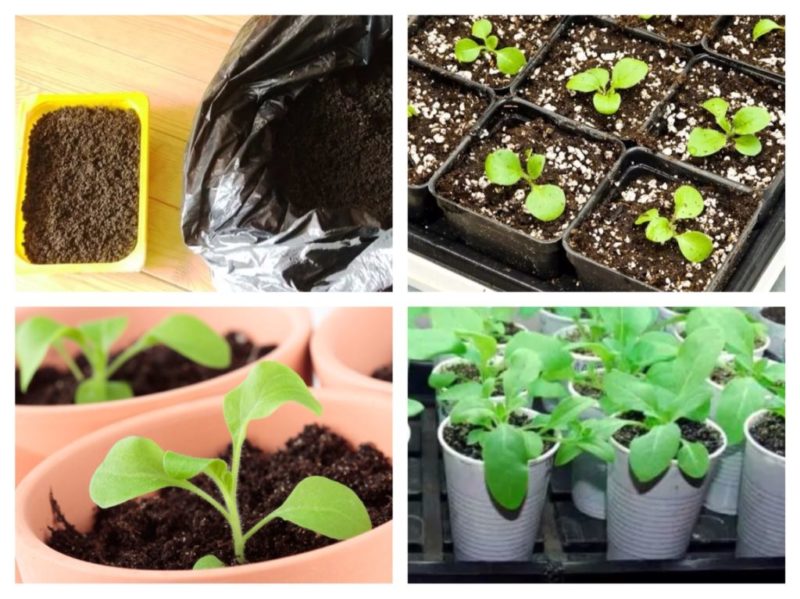
Petunia seeds are sown in a common box. It is better if it is a wide container 10-15 cm high, but plastic cups, cut-off bottles and cake packaging are also suitable.
Containers must be disinfected by pouring boiling water or soaking in a dark pink solution of potassium permanganate.
It is convenient to use peat tablets. They are prepared as follows:
- The tablets are placed in a deep container with the hole facing down and poured with boiling water. The water should completely cover the workpiece.
- When the liquid is absorbed, add more boiling water.This is done until the tablets completely swell and turn into bags.
- The swollen tablets are taken out and turned over with the hole facing up. Excess liquid is drained. The bags are placed on a pallet.
For petunias, slightly acidic or neutral is suitable priming. There are several options for suitable compositions:
- Purchased soil mixture - universal soil for seedlings or special for flowers.
- A mixture of garden soil and hydrogel in a 1:1 ratio.
- Fertile mixture: 2 parts each of garden soil, peat and humus and 1 part sand.
The soil is disinfected. It is calcined in the oven, poured with a hot solution of copper sulfate or potassium permanganate.
In addition to the soil, you will need drainage (shell rock, small expanded clay, crushed ceramics, etc.). It is also disinfected.
Methods of sowing seeds
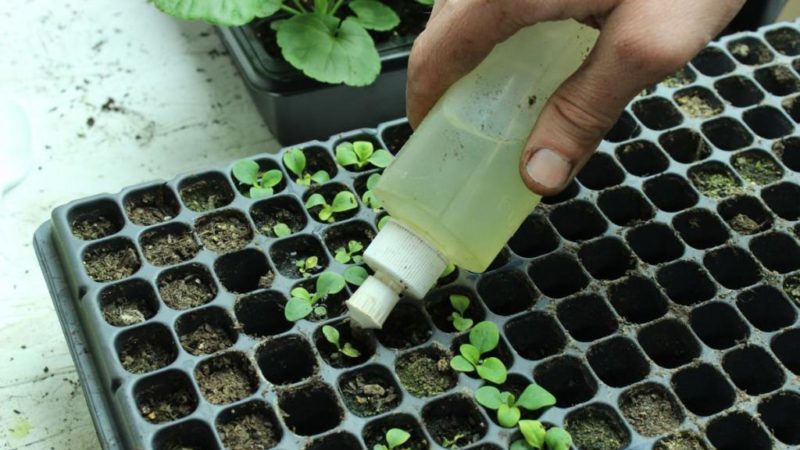
Before planting petunia, you need to properly fill the container with soil. A 1-2 cm layer of drainage is placed at the bottom of the box. The soil is poured on top so that 3-5 cm remains free to the upper borders of the container. The soil is moistened with a spray bottle with warm water.
Granulated seeds are laid out in rows at a distance of 2-4 cm from each other and slightly pressed into the soil, but not covered with soil.
It is more difficult to work with loose planting material. There are three sowing methods:
- Toothpicks. Seeds are poured onto a sheet of paper. The tip of the toothpick is moistened with water and touched to 1 seed. The stuck planting material is transferred to a pot and lowered onto the ground using a second toothpick. The seeds are laid out in rows at a distance of 2-3 cm from each other, without being buried in the ground. The soil is sprayed with warm water from a spray bottle.
- With sand. Planting material is mixed in a separate container with sand.The resulting mixture is distributed in an even layer over the soil, and then sprayed with warm water from a spray bottle.
- To the snow. A layer of snow is placed on top of the soil in the seedling container. Seeds are sown on it in rows at a distance of 2-3 cm from each other.
The container with the crops is covered with film or glass. Then they are removed to a warm, bright place.
Seedling care
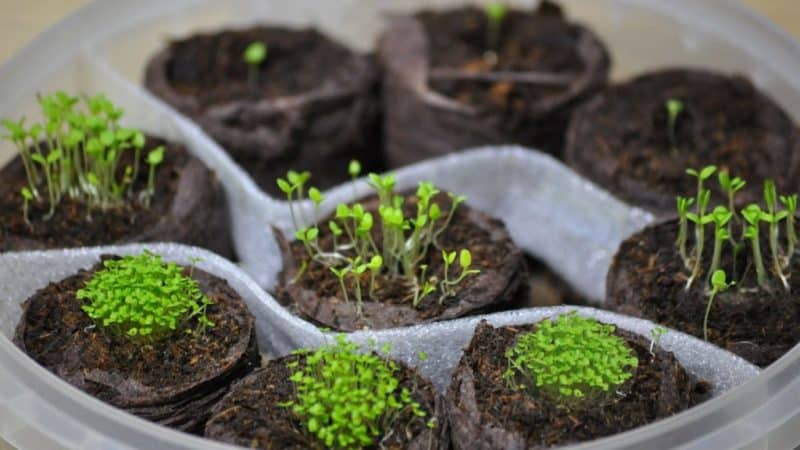
To grow petunia from seeds and get seedlings just like in the store and even better, it is important to provide the plants with optimal conditions for growth and proper care. Otherwise, the petunia will turn out elongated, weak and will not take root when transplanted into the ground.
How to grow petunia at home:
- Temperature. Before seed germination, the room temperature should vary between +24…+26°C. After the first shoots appear, the temperature is reduced to +20...+22°C.
- Lighting. Boxes with seedlings are placed on a south or south-east window sill. They should be there even if the seeds have not yet sprouted. If possible, provide additional illumination for 12 hours. When sowing seeds in winter, illumination is necessary.
- Watering. Before the seeds germinate, the soil is sprayed with warm water from a spray bottle. You cannot water it from a watering can or bottle, as in this case the seeds will go deep into the soil and will not germinate. After the first shoots appear, the seedlings are watered with a syringe or a special watering can for indoor plants with a narrow spout. The liquid should not get on the leaves of the plants. The soil is moistened as it dries with warm water. Do this in the morning or evening, when the sun is inactive.
- Greenhouse. Before the first shoots appear, the seedlings should be under glass or film. Every day the greenhouse is removed, the condensation is wiped off and the container is left to ventilate for 10-20 minutes.When the seeds germinate, the duration of ventilation is increased. Then the greenhouse is completely dismantled.
- Picking. It is carried out when the petunia has 2 true leaves. Use containers with a volume of 250-300 ml. Drainage is poured onto the bottom. The rest of the volume is covered with soil. The seedlings are carefully removed from the common container, trying not to damage the roots, and transplanted into individual pots. Plants are watered at the root with warm, settled water. The plants are replanted the second time when the root system fills the container (1.5 months after sowing the seeds).
- Formation. In order for the bush to branch well and form correctly, it is pinched when 3-4 pairs of leaves are formed on the plant. This stimulates the development of side shoots.
- Hardening. 2 weeks before planting in open ground, seedlings begin to harden. It is taken outside or onto the balcony for 3 minutes, then for 1 hour. Gradually increasing the time, it is left in such conditions for a day.
- Feeding. There is no need to feed the seedlings before picking, but some gardeners add a few drops of Epin to the water for irrigation once a week. After transplanting into individual containers, petunia is fed every 2 weeks, alternating mineral and organic fertilizers.
When to plant petunia in open ground
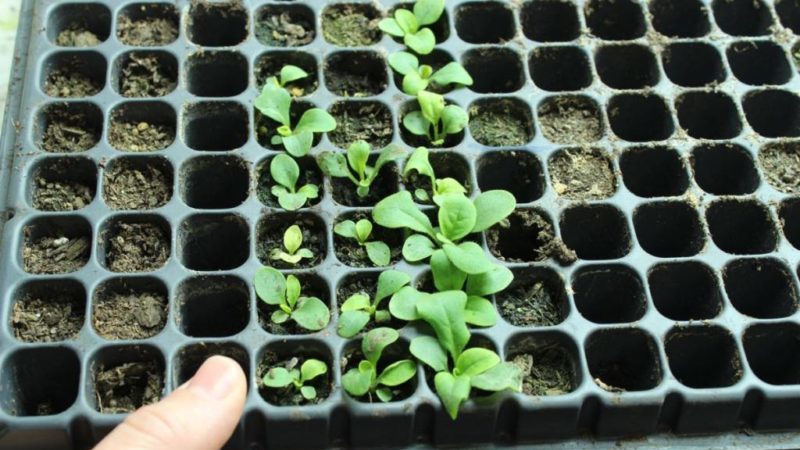
In the southern regions this is done already in the first half of May, in the Moscow region and other central regions - at the end of spring, and in the northern regions - in the second half of June.
To plant petunias, choose a well-lit area of the garden with fertile soil. First, humus is added to the soil (6 kg per 1 sq. m) and watered with a hot solution prepared from 1 tbsp. l. copper sulfate and 10 liters of water.
Advice. Low-growing petunia looks great as a flowerbed frame.
The planting scheme for petunia depends on its variety:
- With small flowers. The bushes are planted at a distance of 8-20 cm from each other.
- With large inflorescences. The distance between plants is from 23 to 25 cm.
- Ampelous petunias. The free space between petunias should be at least 28-30 cm.
The average depth of the hole is 10 cm. 1 tbsp is poured into the recesses. l. ash and pour in water. After this, petunia is planted.
Gardening tips
Experienced gardeners know several secrets on how to grow petunia from seeds at home. They will help speed up plant growth, improve their quality and avoid various problems:
- To speed up the growth of petunia, when preparing a soil mixture from garden soil and hydrogel, the latter is soaked not in water, but in a solution of a growth stimulant. Hydrogel is used to keep the soil moist longer.
- When choosing soil for petunias, it is important to pay attention to the type of peat. High red peat has high acidity, which is harmful to the plant. Lowland black peat is optimal for growing petunia seedlings.
- Petunia sand should be white or gray. Its river variety is best suited. Yellow sand contains a lot of iron, which is harmful to the plant.
- It is not recommended to place petunia near a switched on battery. Dry hot air is detrimental to seedlings.
- Some gardeners recommend cutting the central root by a third during the second transplant in order to stimulate the root system to grow laterally. However, this is not necessary, since during replanting the root system is damaged in any case.
Read also:
How dangerous are aphids on petunias and how to effectively fight them.
A guide to cutting petunia in the summer for novice gardeners.
Conclusion
Growing petunia seedlings is a long process that requires constant attention from the grower. Young plants are demanding in terms of temperature, soil composition, watering and formation.
However, if you know the basic rules and nuances, even a beginner can cope with growing petunia. The main thing is to choose high-quality planting material and strictly follow the step-by-step planting instructions.